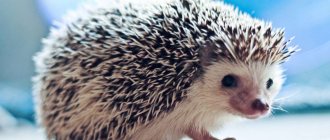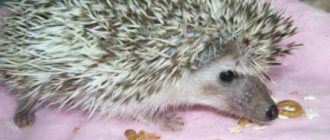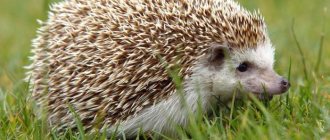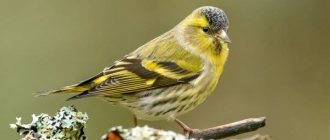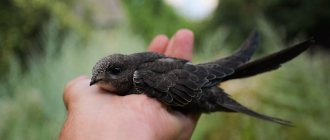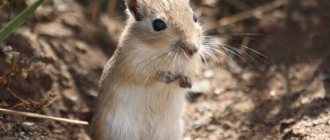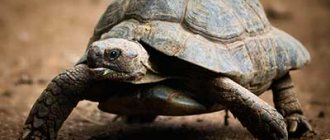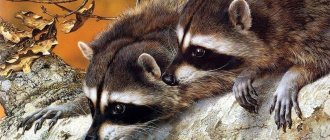- Wild animals
- >>
- Mammals
The Daurian hedgehog is a small insectivorous mammal.
Of all the representatives of the hedgehog family, this species has been the least studied, as it leads a secretive, secluded lifestyle. Of all existing hedgehogs, they are the least prickly and the most ancient animals. This is due to the fact that the animal’s spines are not directed upwards, like all other hedgehogs, but backwards. Daurian hedgehogs got their name due to their habitat region - Western Amur region and Transbaikalia. In former times these places were called Daurian. Unfortunately, today they are on the verge of complete extinction. This is the least studied species of hedgehogs that exists today.
Origin of the species and description
Photo: Daurian hedgehog
The Daurian hedgehog is a representative of chordate mammals, belongs to the order of insectivores, the family of hedgehogs, the steppe hedgehogs are classified in the genus, the class Daurian hedgehogs. Zoologists determine the approximate age of animals - 15 million years. The Daurian hedgehog aroused the greatest interest among scientists and researchers in the mid-sixties, when one of the representatives of this species was accidentally almost destroyed during the distribution of insecticides to kill rodents.
Video: Daurian hedgehog
In ancient times, among all mammals, hedgehogs are second only to armadillos. Zoologists call paleoryctids the ancient ancestors of the Daurian hedgehog. They were quite common in America and modern Europe. They were considered earth-moving and insectivorous representatives of the animal world of that period. This is evidenced by the high and pointed tips of the teeth. Subsequently, it was the paleoryctids that would become the ancestors of the hedgehog family. This will happen during the middle and late Paleocene.
The first shrews were arboreal, but during the Middle Eocene they already led a lifestyle familiar to modern hedgehogs and moles and practically had the appearance of modern mammals. They were forced out of the trees by more developed and intelligent creatures - primates. Hedgehogs managed to retain many primitive features, and at the same time, in the process of evolution, acquired many features similar to various species of mammals.
Human interaction
It is impossible to say unequivocally that a hedgehog only brings benefits to humans, since it is a carrier of harmful diseases such as yellow fever, tick-borne encephalitis, rabies, salmonellosis, tularemia and others. This is all due to the fact that small animals contain fleas and ticks.
But, on the other hand, it also brings benefits to humans by eating harmful pests in summer cottages - chafer beetles, monk caterpillars, and weevils. Therefore, about this type of animal, we can say that its presence is half useful.
Many peoples have appreciated the taste of hedgehog meat. For example, in England, hedgehog stew is still prized, and gypsies love hedgehog meat baked over a fire.
Appearance and features
Photo: Daurian hedgehog in nature
The body length of the Daurian hedgehog is approximately 19-25 centimeters. Particularly large individuals in rare cases can reach 30 centimeters. The body weight of one adult individual is 500 – 1100 grams. The greatest body weight is observed in the period before winter, when the animals try to eat as much food as possible before the hungry season. Due to the lack of food supply in winter, they lose up to 30-40% of their body weight. The animals have a small tail, the length of which does not exceed 2-3 centimeters.
The entire body of the Daurian hedgehog is covered with thick and durable needles, which, unlike other representatives of the hedgehog family, are directed not straight up, but backward. The needles on the body of the animal are arranged in longitudinal rows. The head area is also covered with a continuous protective shell of needles. The length of the needles is approximately 2-2.5 centimeters.
In addition to the needles, the body of the small animal is covered with dense, coarse fur. Fur color may vary. In the head area it is most often light, straw-yellow, or slightly brownish. The body is covered with light brown or gray fur. The belly area is covered with coarse, dense hair, which has a darker shade, in contrast to the back. The needles are most often off-white, sandy or grayish in color. Because of this, the overall color scheme takes on a grayish-brown tint.
The head of the Daurian hedgehog is cone-shaped with an elongated nose. At the top of the head on the sides there are small, rounded, forward-facing ears. Hedgehogs' eyes resemble two beads. They are small, black, round. The limbs of animals are very strong and well developed. The paws are short but thick. The fingers have long, thick claws.
Behavior of an ordinary hedgehog
After frost sets in, the hedgehog closes the entrance to its burrow and goes into hibernation, on average from October to April. During the summer, the hedgehog stores a lot of fat, since if it is less than 500 g, then in winter it can die of hunger. After hibernation, the animal leaves the nest after the temperature rises to 15 °C.
Shedding is slow and occurs in spring or autumn. During the year, one needle out of three changes and grows from 12 to 18 months. The hedgehog carefully takes care of the needles - licks and cleans.
The common hedgehog is a fairly fast animal for its size. It reaches speeds of up to 3 m/s, swims and jumps well. The hedgehog's eyesight is poor, but it has a keen sense of smell and hearing.
The lifespan of an ordinary hedgehog in nature is 3-5 years, in captivity up to 8-10 years.
Where does the Daurian hedgehog live?
Photo: Daurian hedgehog in Russia
Geographical regions of the hedgehog's habitat:
- Mongolia;
- South-Eastern Transbaikalia on the territory of the Russian Federation;
- China;
- Selenga Duaria;
- territory of the Borschevochny and Nerchinsky ridges;
- area near the Ingoda, Chita and Shilka rivers;
- Chita region of the Russian Federation;
- Amur region of the Russian Federation;
- Manchuria.
The animal densely inhabits the territory of the Daursky Nature Reserve; their populations are also numerous in the Chasucheysky Forest. The animal prefers steppes, semi-desert areas, mountainous or rocky areas as its habitat. You can often find these small animals in ravines with abundant, dense thickets of cotoneaster and almond, as well as on the slopes of hills. They try to avoid regions with thick and tall grass.
Interesting fact: Hedgehogs are not at all afraid of people, and often live in close proximity to human settlements or agricultural land.
Predominantly dry places are chosen as the habitat region. In the northern regions, sandy places are preferred. They also feel comfortable in deciduous and mixed forests. In the steppes it is found in areas where vegetation and grass are not too tall. Most often they hide under stones or various depressions in the soil. With the onset of the rainy season, they tend to look for shelter and hide in it almost constantly.
Habitat
These hedgehogs live in the steppes, taiga and forest-steppes of Transbaikalia. Their habitat also covers the northeast of Mongolia and the northern part of China. Basically, these animals prefer pine, deciduous and mixed forests, but also live in steppes with low vegetation. In addition, Daurian hedgehogs can be found in semi-deserts. They are also found in agricultural zones and on the outskirts of populated areas. And they avoid steppes with thick, dense grass.
We invite you to read: Longhaired Burmilla features and description of the breed
The habitat of the Daurian hedgehog is the territory of Russia, namely the Chita and Amur regions, Primorsky Krai, Central and Southern Transbaikalia, part of the territory of which was previously called Daurian land. This gave the name to the animals living in its areas: white-naped marmot, white-naped crane, white-naped hedgehog (photo provided).
The spiky beauty can also be found in Eastern Mongolia, Manchuria and Northeast China. True, encounters are not as frequent as we would like, since in the 60s of the last century, the habitats of the Daurian hedgehog were treated with strong pesticides, which resulted in the death of a huge number of representatives of this class of animals. In this case, the hedgehog turned out to be an accidental victim, since the effect of the toxic substances was directed against the carriers of the plague - field rodents.
In its natural environment, the habitat of the Dahurian hedgehog is steppe areas, as well as semi-desert and mountainous areas with rocky areas. It settles in abandoned rodent burrows, does not shy away from dense bushes, natural niches in the soil and under stones. Avoids areas with dense grass.
What does the Daurian hedgehog eat?
Photo: Daurian hedgehog from the Red Book
Daurian hedgehogs are insectivores. The main part of the diet is various insects, which the animal can dig up in the ground with the help of powerful paws and strong claws. However, it is safe to say that the animal’s diet is very varied and rich.
Food supply of the Daurian hedgehog:
- beetles;
- ants;
- ground beetle;
- quail eggs;
- crickets.
In addition to insects, animals that live near agricultural lands and human settlements feed on scraps and grains and cereals. In natural habitats, they can catch and eat a hamster, frog, mouse, snake, chicks hatched from eggs, if bird nests are located within its reach.
They may also eat vegetation. In this type of food, preference is given to almonds, rose hips, and cotoneaster. However, it can feed on almost any berries and other succulent varieties of forest vegetation. During periods when the food supply is especially scarce, they can feed on carrion.
Habitat
The distribution area of the Daurian hedgehog covers the steppe, forest-steppe and partially southern taiga zones of Transbaikalia and the southeast of Transbaikal Territory and adjacent territories of northeastern Mongolia and Northern China. To the north it occurs sporadically, penetrating river valleys. The habitat of the hedgehog is established in the valleys of the Ingoda, Chita and Shilka rivers;
The common habitats of Daurian hedgehogs are all types of steppes, pine forests, dwarf birches, agrocenoses, surroundings and outskirts of populated areas. In the southern taiga zone, the hedgehog lives in steppe areas, in dry pine, larch, birch and mixed forests. Avoids areas of steppes with thick, dense grass. Loves areas with a combination of good protective and feeding conditions - hill slopes with thickets of caragana, almond and cotoneaster, cut by ravines.
The habitat of the Daurian hedgehog is the territory of Russia, namely the Chita and Amur regions, Primorsky Krai, Central and Southern Transbaikalia, part of the territory of which was previously called Daurian land. This gave the name to the animals living in its areas: white-naped marmot, white-naped crane, white-naped hedgehog (photo provided).
The spiky beauty can also be found in Eastern Mongolia, Manchuria and Northeast China. True, encounters are not as frequent as we would like, since in the 60s of the last century, the habitats of the Daurian hedgehog were treated with strong pesticides, which resulted in the death of a huge number of representatives of this class of animals. In this case, the hedgehog turned out to be an accidental victim, since the effect of the toxic substances was directed against the carriers of the plague - field rodents.
In its natural environment, the habitat of the Dahurian hedgehog is steppe areas, as well as semi-desert and mountainous areas with rocky areas. It settles in abandoned rodent burrows, does not shy away from dense bushes, natural niches in the soil and under stones. Avoids areas with dense grass.
These hedgehogs live in the steppes, taiga and forest-steppes of Transbaikalia. Their habitat also covers the northeast of Mongolia and the northern part of China. Basically, these animals prefer pine, deciduous and mixed forests, but also live in steppes with low vegetation. In addition, Daurian hedgehogs can be found in semi-deserts. They are also found in agricultural zones and on the outskirts of populated areas. And they avoid steppes with thick, dense grass.
Features of character and lifestyle
Photo: Daurian hedgehog
Animals lead a hidden, solitary lifestyle. They are most active at night. At this time, they go out on the move and get their own food. They tend to live in a certain territory. Adult, strong males can occupy an area of up to 400 hectares. Females occupy a more modestly sized territory - 30-130 hectares.
Secluded, inaccessible places are chosen as shelter - abandoned badger holes, depressions in the ground, places under stones, snags of trees. Burrows can also be above ground. On the territory of Mongolia they live in tarbagan burrows. Living in shelters is more typical for females; males prefer to sleep simply on the ground.
The animals are not active in damp, rainy weather. With the onset of the rainy season, they try to wait out this time in burrows. However, in cloudy weather, when there is no rain or dampness, they feel great and can be very active even during daylight hours. If a prickly animal senses danger, it instantly curls up into a ball and becomes like a prickly ball.
To make it easier to endure the harsh winter climate of some regions, as well as the lack of a food source, the animals hibernate. It lasts from the end of October, beginning of November to the end of March, beginning of April. Daurian hedgehogs are distinguished by their secrecy and solitary nature.
Interesting fact: Depending on the region and its climate, some hedgehogs can sleep almost 240-250 days a year!
Security
The main protected area for these animals is the Daursky Nature Reserve. The Daurian hedgehog in the reserve is not only protected, it is studied and everything is done to preserve and even increase the population. In the protected zone, measures are taken to prevent fires; there are strict restrictions on the use of chemicals, even for nearby agricultural land.
Social structure and reproduction
Photo: Daurian hedgehog
Animals prefer to lead a solitary lifestyle. They form pairs only during the mating season. It begins a few days after the end of hibernation. The birth of offspring occurs once a year and occurs in May - June. Before the onset of labor, the expectant mother actively searches for and prepares the place for the birth of her future offspring. To do this, she can find an abandoned badger hole, or dig a new one herself. The length of such a shelter can reach one and a half meters. The nesting room is most often located at a depth of 30-50 centimeters from the exit.
Pregnancy lasts on average 35-40 days. A female Daurian hedgehog can give birth to 4 to 6 six little hedgehogs at the same time. Hedgehogs are born almost naked and blind.
Interesting fact: The eyes of Daurian hedgehogs open 15-16 days after birth, and the needles begin to grow within a few hours after birth!
However, they quickly grow and get stronger, and after a month they are ready for independent life. They feed on mother's milk for about one to one and a half months. After two months, they separate from their mother and begin to lead an independent, isolated lifestyle. Females are very attentive and caring mothers. They do not leave their babies for almost a minute until they are completely helpless. If the hedgehog senses the approach of danger, she immediately takes the babies to a safer place.
Sexual maturity is reached at 10–12 months. The average life expectancy in natural conditions is about 4-5 years, in captivity, nurseries and reserves it can increase to 8.
Interesting facts about the animal
Daurian hedgehogs are considered very interesting and unique animals, which are interesting and exciting to watch. Males of this species hibernate earlier than females or young. During the hibernation period, up to 30% of the animal’s body weight is lost.
The lifespan of the Daurian hedgehog ranges from 3.5 to 7 years in natural conditions and up to 8 years in captivity (for example, in a zoo). The female feeds the offspring with milk for 1.5 months.
After this, the hedgehogs gradually wean themselves from her, and by 2 months they become independent. Males reach sexual maturity by 10 months, but due to great competition with older individuals, they begin to reproduce no earlier than 22 months.
Do you have any questions about the Daurian Hedgehog or something to add? Then write to us about it in the comments, this will make the material more useful, complete and accurate.
Natural enemies of Daurian hedgehogs
Photo: Animal Daurian hedgehog
Despite the needles and the external feeling of inaccessibility and security, under natural conditions hedgehogs have enough enemies. Many predators that hunt hedgehogs have adapted to pushing them into a body of water. Once in the water, the animals turn around and predators grab them.
The main natural enemies of Daurian hedgehogs:
- foxes;
- wolves;
- steppe eagles;
- Mongolian barrows;
- badgers;
- ferrets;
- predatory representatives of birds - owls, eagle owls.
Birds of prey are not bothered by the presence of thorns; their powerful paws with strong claws are adapted for grasping and holding even prickly, prickly hedgehogs. Hedgehogs often settle near human settlements. In such a situation, dogs pose a great danger to them, especially large fighting breeds - bull terriers, Rottweilers, shepherds, etc. Hedgehogs are also often attacked by stray packs of dogs.
The main enemy of the prickly animal in natural conditions is the badger. He is able to find and destroy hedgehogs even in burrows. In this situation, it poses a danger not only to adults, but also to young, recently born hedgehogs. They are especially vulnerable due to the fact that they do not have protective spines.
Humans can also be called enemies of the Daurian hedgehog. As a result of its activities and the development of ever larger territories, the natural habitat of these representatives of the hedgehog family is polluted and destroyed. As a result, the number of animals decreases sharply.
Hedgehog diet
The European hedgehog is an omnivore. The main part of its diet consists of insects, slugs and caterpillars, and earthworms. Hedgehogs also feed on sweet berries and fruits, and seeds of cereal plants. Sometimes they eat mushrooms, acorns and moss, and they can also eat food waste found in summer cottages.
In natural habitats, these mammals rarely attack vertebrates; torpored amphibians and reptiles become victims of hedgehogs. Northern populations of representatives of the hedgehog family feed on frogs, lizards, mice and other small rodents (shrews, voles). They love to feast on the eggs and young chicks of ground-nesting birds. In general, hedgehogs are very voracious and in one night of hunting can eat an amount of food equal to 1/3 of their own weight.
Interesting fact
The hedgehog is an omnivore, in nature it feeds on both insects and fruits. Among insects, he happily eats earthworms, beetles, spiders, caterpillars, slugs, earwigs, and ground beetles. Hedgehogs love lizards, mice, bird eggs, frogs and toads, locusts, crustaceans and invertebrates. In addition to mice, the wild hedgehog also feeds on other small rodents; its diet is incredibly varied.
In addition, it is resistant to poison, such as snakes and scorpions, which allows you to dine on them without fear. From plant foods, the common hedgehog eats cereals, raspberries, mushrooms, apples, strawberries, blackberries, moss, and acorns. But they won’t eat carrion and garbage in their summer cottages, that’s a myth! The hedgehog eats well over the summer, since in winter it can die during hibernation. It is the fat reserve that allows them to survive hibernation from October to April.
We invite you to familiarize yourself with hagfish reproduction and nutrition
1. The hedgehog appeared on Earth 15 million years ago
2. The ancient Romans used hedgehog skins to comb their sheep.
3. In hibernation, the temperature of a hedgehog can reach 2 degrees
4. Fried hedgehog - a favorite delicacy of gypsies
5. Hedgehogs are not able to catch up with a mouse, although they are not averse to such prey
6. Serbs treat alcoholism with hedgehog urine, and use his little heart as a talisman
7. As we often see in cartoons, a hedgehog on needles drags mushrooms or apples - this is a myth! It is not able to curl up in such a way as to place food on the needles
8. At the beginning of the 20th century, the McDonalds restaurant chain killed many hedgehogs completely by accident. The fact is that the ice cream cups were narrow, and the hedgehogs at the garbage dumps happily stuck their heads into these cups and licked the remnants of the sweet, but the trouble was that due to the diameter, they could not pull their heads back and fell into the trap! Animal rights activists protested, and the restaurant increased the diameter of the glass.
What do hedgehogs eat? The main diet of animals is plant food. Hedgehogs have priority:
- Beetles.
- Little frogs.
- Small lizards.
- Worms.
- Mice.
- Small insects and their larvae.
- Snails.
- Slugs.
- Eggs of some birds.
- Only newly born chicks.
The unique structure of the jaw allows hedgehogs to chew through rough food. In addition to living creatures, the hedgehog eats tree fruits and berries. Living in captivity, this small animal can eat milk, baked goods, apples, meat and cereal porridge.
Population and species status
Photo: Daurian hedgehog Russia
Today, the Daurian hedgehog is listed in the Red Book of the Russian Federation, as its population within the country is rapidly declining. According to zoologists, in the main territory of its distribution in Russia - in the southeastern Transbaikalia, the number of these representatives of the hedgehog family is 550,000 - 600,000 individuals.
The International Union for Conservation of Wildlife has concluded that the total number of animals is not currently under threat. However, they emphasize that if in the future the natural habitat of the animals continues to be destroyed due to human activity, the population of Daurian hedgehogs may decline sharply. This may also cause a significant reduction in the natural habitat of these representatives of the hedgehog family.
A sharp decline in the number of Daurian hedgehogs was noted in the sixties. During this period, mass extermination with insecticides of rodents and Mongolian tarbagans, which were carriers of a dangerous disease - plague, began. After this, in some regions the number of animals did not exceed 1-1.5 individuals per 80 hectares of area. However, habitat densities near agricultural land and human settlements remained unchanged.
Interesting fact: In the 70-80s, the number of predatory animals in some regions of the Daurian hedgehog's habitat decreased significantly. This led to a sharp increase in the number of this representative of the hedgehog family.
Habitat
The habitat of the Daurian hedgehog is the territory of Russia, namely the Chita and Amur regions, Primorsky Krai, Central and Southern Transbaikalia, part of the territory of which was previously called Daurian land. This gave the name to the animals living in its areas: white-naped marmot, white-naped crane, white-naped hedgehog (photo provided).
The spiky beauty can also be found in Eastern Mongolia, Manchuria and Northeast China. True, encounters are not as frequent as we would like, since in the 60s of the last century, the habitats of the Daurian hedgehog were treated with strong pesticides, which resulted in the death of a huge number of representatives of this class of animals. In this case, the hedgehog turned out to be an accidental victim, since the effect of the toxic substances was directed against the carriers of the plague - field rodents.
In its natural environment, the habitat of the Dahurian hedgehog is steppe areas, as well as semi-desert and mountainous areas with rocky areas. It settles in abandoned rodent burrows, does not shy away from dense bushes, natural niches in the soil and under stones. Avoids areas with dense grass. Often the homes of the spiky beauty are located near human habitation. This is explained by the absence of predators, the presence of secluded shelters and sufficient food.
